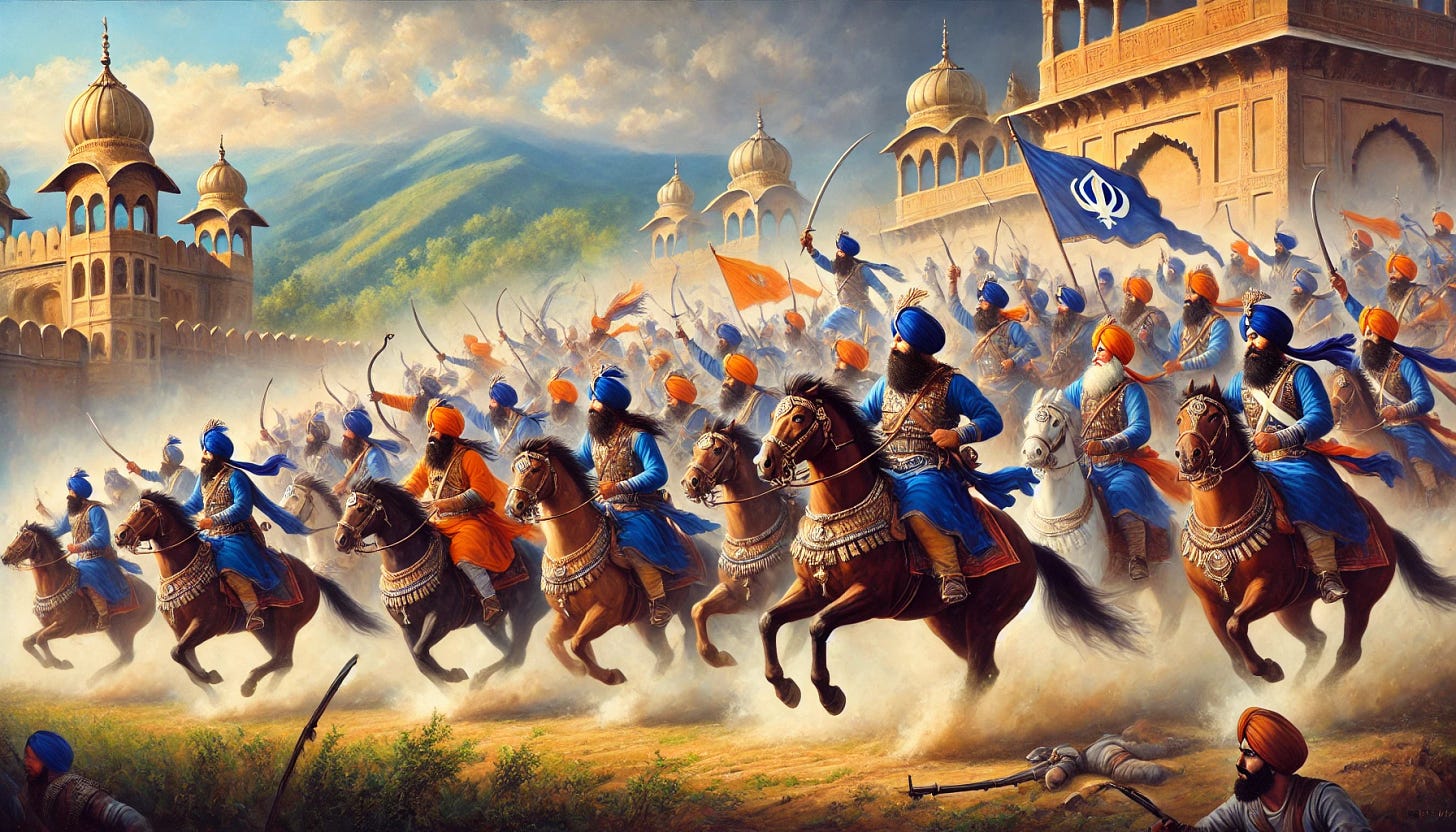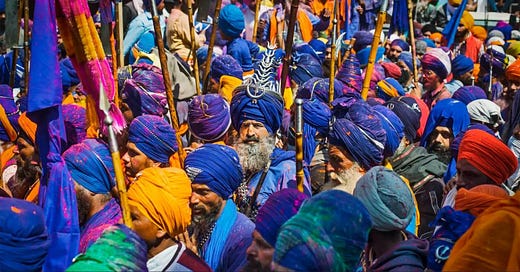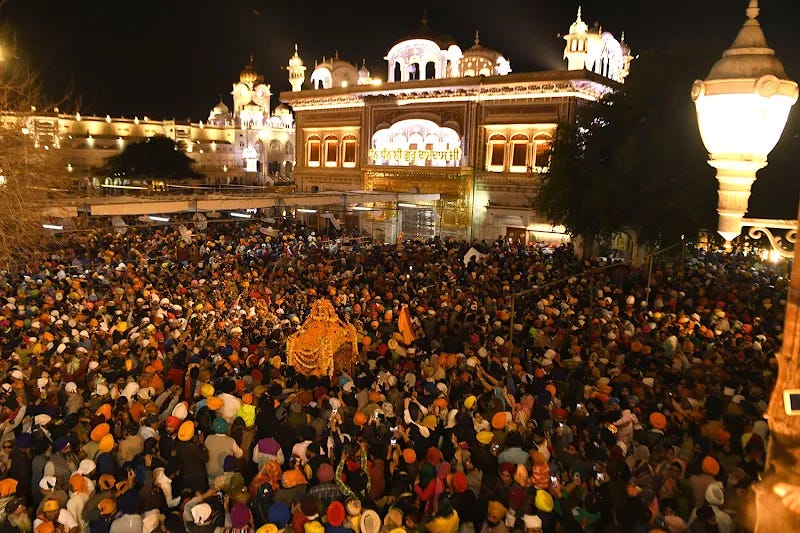Hola Mohalla: Guru Gobind Singh Ji’s Legacy of Courage, Brotherhood, and Devotion
As we commemorate Hola Mohalla in 2025, let us rekindle the fire of our faith, strengthen the bonds of brotherhood, and bow our heads in humble devotion before Sri Guru Granth Sahib Ji.
Hola Mohalla: A Sacred Confluence of Courage, Brotherhood, and Devotion
Hola Mohalla is not merely a festival; it is the resounding battle cry of the Khalsa, an embodiment of the spirit of Guru Gobind Singh Ji’s saint-soldier ideal. Celebrated annually at the divine precincts of Anandpur Sahib, this three-day grand spectacle reaffirms the Sikh ethos of unwavering faith, martial preparedness, and selfless service. Established in 1701 by Guru Gobind Singh Ji himself, Hola Mohalla stands as an enduring testament to the martial and spiritual identity of the Sikhs, a clarion call to uphold righteousness (Dharam) and justice in the face of tyranny.
This year, the sacred gathering assumes an even deeper significance and importance as it coincides with an important panthic development—the new Jathedar of Takht Sri Keshgarh Sahib, Giani Kuldip Singh Gadgaj, assumed his duties in an unexpected early morning transition on 10 March. While this assumption of ‘sewa’ has generated debate regarding internal stress within Sikh leadership, the collective strength of the Sikh Panth remains steadfast, bound by an unshakeable faith in Sri Guru Granth Sahib Ji, the eternal Guru, and the teachings of of other Sikh Gurus, including Guru Gobind Singh Ji.
The Legacy of Guru Gobind Singh Ji and the Birth of Hola Mohalla
During the perilous years of Mughal oppression, Guru Gobind Singh Ji infused the Sikh spirit with unparalleled resilience and divine purpose. Hola Mohalla was instituted at a time when the nascent Khalsa was being forged in the fires of relentless persecution. Unlike Holi, the festival of colours, Guru Sahib envisioned Hola Mohalla as a celebration of discipline, martial skill, and unwavering faith. It was designed not for fleeting amusement but for the eternal empowerment of the Khalsa.
The term Hola derives from Holi, while Mohalla signifies an organised procession akin to a regimented army column. The first Hola Mohalla was observed along the banks of the Charan Ganga rivulet in Anandpur Sahib, where Guru Gobind Singh Ji personally led the Sikhs in military drills, tactical exercises, and spiritual discourse. These gatherings were not mere displays of skill but sacred training grounds where the Sikh community reaffirmed its duty to defend Dharam with sword and spirit alike.
Anandpur Sahib: The Hallowed Ground of Sikh Sovereignty
Nestled in the foothills of the Shivalik range, Anandpur Sahib—The City of Bliss—is not just a geographical location but the very soul of Sikhism’s martial and spiritual legacy. It was here in 1699 that Guru Gobind Singh Ji created the Khalsa, a sovereign brotherhood of the pure. The town remains imbued with the presence of the Guru, and Hola Mohalla transforms its streets, forts, and sacred precincts into a vibrant manifestation of Sikh valour.
The fortress of Holgarh, where Guru Sahib conducted mock battles, continues to serve as a focal point for the festival’s martial demonstrations. Every year, Anandpur Sahib becomes an ocean of saffron and blue, with thousands of devotees reaffirming their commitment to the Guru’s vision.

The Living Traditions of Hola Mohalla
The Roar of the Khalsa: Martial Displays and Gallant Feats
No celebration captures the spirit of Sant-Sipahi (saint-soldier) like Hola Mohalla. The Nihang Singhs, the formidable defenders of Sikh sovereignty, take centre stage, displaying their centuries-old traditions of warfare. Armed with traditional weaponry—Kirpans, spears, and chakrams—they perform awe-inspiring feats of Gatka (Sikh martial arts), horseback riding, tent pegging, and combat drills. These are not mere spectacles but living traditions of Sikh martial prowess, ensuring that the Sikh nation remains ever vigilant and prepared.
The breathtaking procession led by Nihang Singhs, dressed in majestic blue robes with towering turbans adorned with dumalas and chakrams, reverberates with the sounds of Jaikara—"Bole So Nihal! Sat Sri Akal!"—rekindling the indomitable spirit of the Khalsa.
The Eternal Guru’s Presence: Kirtan, Katha, and Ardaas
Hola Mohalla is not just a demonstration of valour but also a profound spiritual retreat. The sacred verses of Sri Guru Granth Sahib Ji permeate the air as Kirtan and Katha sessions provide nourishment to the soul. The Panj Pyare, carrying the Guru Granth Sahib Ji, lead majestic processions, reinforcing the Sikh doctrine that the Guru is ever-present, guiding the Panth towards righteousness.
From the ambrosial hours (Amrit Vela) until the late hours of the night, Anandpur Sahib resonates with divine hymns, reminding every Sikh of the eternal command—Shabad Guru Surat Dhun Chela—where the Guru’s word reigns supreme, shaping the consciousness of the Khalsa.
Seva and the Langar Tradition: A Manifestation of Sikh Compassion
If valour and devotion form the pillars of Hola Mohalla, Seva (selfless service) is its beating heart. The tradition of Langar, instituted by Guru Nanak Dev Ji and upheld by every Sikh Guru, reaches its pinnacle during this festival. Thousands of volunteers tirelessly prepare and serve free meals to all, embodying the Guru’s vision of equality and compassion. Regardless of caste, creed, or social status, every individual partakes in the Guru’s Parshad, reinforcing the fundamental Sikh principle of Sarbat da Bhala—welfare for all.
Beyond Langar, the spirit of Seva manifests in countless forms—medical camps, aid for travellers, and assistance to the elderly—reflecting the Guru’s command that a Sikh’s hands should always be engaged in service.
Hola Mohalla and the Contemporary Sikh Struggle
While Hola Mohalla remains a festival of grandeur and joy, it also serves as a poignant reminder of the Sikh struggle for sovereignty, dignity, and justice. The internal debates within the Sikh leadership today echo historical challenges that the Panth has faced since the times of Guru Gobind Singh Ji. However, the teachings of Sri Guru Granth Sahib Ji provide an unwavering beacon of guidance, ensuring that unity prevails over discord.
Even as Sikh institutions grapple with internal and external pressures, the resounding spirit of Hola Mohalla sends a powerful message: the Khalsa is eternal (Akal Purakh ki Fauj), and its commitment to Guru Gobind Singh Ji’s vision remains unbroken.
The Eternal Call of the Khalsa
Hola Mohalla is not a mere festival; it is a sacred duty, a reaffirmation of Sikh identity, and an unshakeable resolve to uphold truth and righteousness. Every Sikh who walks through the streets of Anandpur Sahib during this sacred occasion walks in the footsteps of Guru Gobind Singh Ji, literally as well as metaphorically. Every Jaikara that echoes across the plains of Punjab reverberates with the unyielding spirit of the Khalsa.
As we commemorate Hola Mohalla in 2025, let us rekindle the fire of our faith, strengthen the bonds of brotherhood, and bow our heads in humble devotion before Sri Guru Granth Sahib Ji. May the undying spirit of Guru Gobind Singh Ji continue to inspire generations to come, ensuring that the Panth remains ever victorious, ever united, and ever devoted to the path of righteousness.
"ਚਿੜੀਆਂ ਤੋੰ ਮੈਂ ਬਾਜ ਤੁਡਾਵਾਂ, ਗਿਦੜਾਂ ਤੋੰ ਮੈਂ ਸ਼ੇਰ ਬਣਾਵਾਂ, ਸਵਾ ਲਾਖ ਸੇ ਏਕ ਲੜਾਵਾਂ, ਤਬੇ ਗੋਬਿੰਦ ਸਿੰਘ ਨਾਮ ਕਹਾਵਾਂ!"
("Chirīāṅ toṅ main bāj tuḍāvāṅ, gidṛāṅ toṅ main sher banāvāṅ, savā lākh se ek laṛāvāṅ, tabe Gobind Singh nām kahāvāṅ!")
("I will make sparrows hunt falcons, I will turn jackals into lions, I will make one fight against 125,000, only then shall I be called Gobind Singh!")





